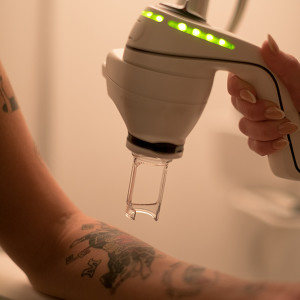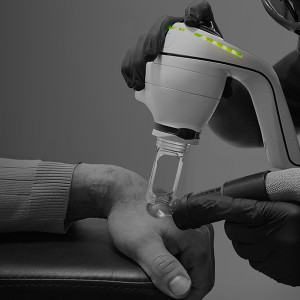Everything you need to know about colour tattoo removals.
It’s commonly misunderstood that colour tattoos can’t be removed with laser tattoo removal. Thankfully technology has come a long way, and NAAMA is at the forefront of it.
Read on for our deep-dive into how colour tattoo removal works and why NAAMA’s LightSense™ is the best-in-class laser at removing coloured inks.
Publish Date in article
What is a coloured tattoo?
A coloured tattoo is any body art design made using ink other than black. There are many different colours of ink available for tattoos, and tattoo artists can mix these inks to create a wide range of shades and hues. Coloured tattoos can be used to create a variety of effects, from subtle gradations of colour to vibrant and bold designs. Some people choose to have a coloured tattoo because they want something more unique or eye-catching than a traditional black tattoo, while others may want to use colour to represent a specific meaning or symbol.
As the art of tattooing has evolved over the centuries, tattoo artists have experimented with a wide range of different materials for creating coloured tattoos. Some of the earliest coloured tattoos were made using natural dyes, such as plant and fruit extracts, to create a range of colours. Later, tattoo artists began to use pigments made from minerals and other materials to create a wider range of colours. Today, tattoo inks are made using a variety of synthetic dyes and pigments, and these inks can be mixed to create a wide range of shades and hues.
What is coloured ink made from?
Today, the ink used in coloured tattoos is typically made from a combination of pigments and a carrier solution. The pigments used in tattoo inks are finely ground particles of colour that are suspended in the carrier solution. Here's how it works:
- A carrier solution is a type of liquid that is used to suspend particles of a solid material in a liquid form.
- This allows the solid material to be easily applied or used, and it can help to preserve the properties of the solid material. It’s a technique that is often used in painting.
- In the case of tattoo inks, the carrier solution is typically a mixture of water and glycerin, which helps to keep the pigments suspended in the ink and allows the ink to be easily applied to the skin.
The type of pigment used in a tattoo ink can vary depending on the colour of the ink. For example, tattoo inks that are red or orange may use pigments made from iron oxide, while inks that are blue or green may use pigments made from copper.
Publish Date in article
Different colours have different wavelengths so we adjust the settings accordingly to effectively break down the coloured ink pigments.
How does colour tattoo removal work?
Colour removal works the same way traditional laser removal does, by emitting high concentrations of light to reach the deeper layers of the skin and target where the coloured inks sit.
We asked Verity, one of the expert tattoo removal consultants at NAAMA, to break down the process for us (pun very much intended):
1. “The coloured ink particles are broken apart by the laser into tiny pieces,” she says.
2. “Then the pieces are flushed out the body via the lymphatic system.”
3. This process continues to happen over a series of sessions till the ink is fully gone.
Another important factor in colour removal? Wavelengths.
Unlike black ink, colours absorb different amounts of light at different rates so the most effective way to break them down is to adjust the laser’s wavelengths. With the right wavelengths administered over a series of treatments, the ink colours will continue to break down and be cleared out by the body until the tattoo is gone from the skin.
Publish Date in article
Can a colour tattoo be completely removed?
Yes, colour tattoos can be removed with modern laser technology but the effectiveness will greatly depend on which laser you choose. It’s important to find a studio that offers a variety of wavelengths to treat different colours. If a tattoo is unable to absorb the laser’s light, it’s most likely because an unsuitable laser wavelength was used for the colour.
What is the best laser device for removing a colour tattoo?
NAAMA is the leading tattoo removal studio when it comes to removing coloured inks, using a one-of-a-kind 800 nanometre (the measurement equals one thousand-millionth of a metre) laser to pinpoint coloured ink and break it down fast and with superior results. We combine a higher pulse repetition rate and lower energy to deliver far more successful removal results in less time that does not damage the skin.
Colour tattoo removal before and after one session with NAAMA's 800nm laser.
One of the laser engineers at NAAMA, Jordan explains this process further. He says that the laser emits “ultra-short pulses of light that break down the coloured ink molecules in your tattoo much more effectively even at lower energies.”
To anyone worried about potential colour removal side effects, NAAMA is the safest laser tattoo removal option. The laser is tough on coloured tattoos, but especially kind to your skin.
Does colour tattoo removal cost more?
Some places might charge more for a colour removal, but at NAAMA the price stays the same whether your tattoo is black or coloured ink. What determines the price is the tattoo size and time.
NAAMA offers three different tattoo removal packages:
- Micro - tattoos smaller than 4cm x 4cm
- Standard - most tattoos
- Ultra - larger tattoo sizes
Another bonus of NAAMA? You often treat multiple tattoos in one go under the Standard or Ultra tattoo removal packages. Many other places charge by tattoo, so this is a really great offer if you happen to want more than one tattoo gone. Explore tattoo removal packages here.
How many sessions does it take to remove a colour tattoo?
“On average it takes 8-12 sessions for full removal; but sometimes it’s less, sometimes it’s more,” says Verity. “However, some colours will fade much quicker than this.”
Another factor is skin tone. Verity adds, “Removal of coloured ink does depend on the client’s skin type and tone, which we use the Fitzpatrick scale to determine.”
The Fitzpatrick scale is a system used to measure how different skin tones react to sunlight. It’s relevant in tattoo removal because it helps us understand how different skin tones will react to a laser’s light. Skin safety is a top priority at NAAMA, and our consultants are on hand to give you the best recommendation for your skin.
Which colours remove the fastest
‘True’ colours remove the best
Colours that aren’t mixed with white or other shades (also sometimes called ‘true colours') tend to see faster removal rates. That’s because there’s less mixing of different pigments, which artists sometimes do to achieve a desired colour.
While mixed shades can take longer to remove depending on what pigment ratio the artist used, it doesn’t seem to slow NAAMA down. The team “sees great colour removal results with 800nm laser,” says Verity. “Specifically on blues and reds.”
White ink is more challenging to remove, but not impossible
“White ink reflects the laser’s light,” says Verity, “which makes it more difficult to remove in some cases.” That’s because white ink often contains zinc and/or titanium that can easily oxidise when the laser beam’s light hits it. Choosing a high quality laser like NAAMA’s will help ensure the results are better than older technologies.
If your tattoo has white in it, the expert NAAMA team can create a bespoke treatment plan and advise the downtime you’ll need between sessions to achieve optimal results.
Ready to say farewell to your tattoo?
If you’re looking for colour tattoo removal near you, Verity suggests speaking to the team directly so they can recommend the right treatment course for your tattoo and skin.









